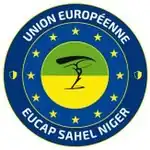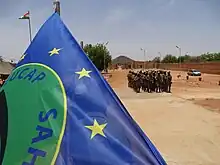European Union Capacity Building Mission in Niger
The European Union Capacity Building Mission in Niger. (EUCAP Sahel Niger) is a civilian capacity-building mission in Niger, launched by the EU in 2012 under its Common Security and Defence Policy (CSDP). Since 5 June 2023, the German judge Katja DOMINIK has been Chief of Mission.
 | |
 | |
| Abbreviation | EUCAP Sahel Niger |
|---|---|
| Formation | 2012 |
| Headquarters | Niamey, Niger |
Head of Mission | Katja DOMINIK |
Parent organization | European Union |
| Website | https://www.eucap-sahel.eu/ |
Mandate
The mandate of EUCAP Sahel Niger was last extended by the EU until September 2024.[1] Currently, the Mission is composed of around 130 European experts.[2]
Since its inception in 2012, the Mission has been mandated to train and advise the Nigerien internal security forces, notably the Police Nationale, the Gendarmerie and the Garde Nationale, with a focus on combatting terrorism, organised crime and irregular migration. More specifically, support to the country's internal security forces include the following:
- Support the security forces in improving their interoperability and with establishing common operating strategies.
- Support the security forces in improving their technical competencies, including their human resources, training and logistics management policies.
- Support the security forces in improving their control over migratory flows and irregular migration and their fight against associated criminal activity.
- Support the country with coordinating regional and international efforts on the fight against terrorism and organised crime.[3]
Concept of Mobile Forces
In the summer of 2022, the Steering Committee (COPIL) for EUCAP Sahel Niger decided to reorient the work of the mission. The focus is now on the mobile forces concept, which envisages doubling the current mobile units of police, gendarmerie and national guard to twelve units in the near future. This concept, in whose realisation EUCAP Sahel Niger plays an important coordinating role for the international partners, is an example of a holistic approach involving all actors on the ground.
History
In response to a request from the Nigerien government, the Mission was established by the Council of the EU in July 2012,[4] initially for a two-year period. The request was prompted by growing concerns over terrorism and organised crime in the region.[5] Colonel Francisco Espinosa Navas was appointed to lead EUCAP Sahel Niger for the first year. [6] The mission was last led by German police officer Antje PITTELKAU, who headed the mission from January 2021 to May 2023.
The Mission's headquarters was set up in Niamey with two liaison offices in Bamako (Mali) and Nouakchott (Mauritania).[7] Whereas the liaison offices in the neighbouring countries were later closed, a field office was opened in the country's northern town of Agadez in 2016.[8]
References
- "EUCAP Sahel Niger: mission prolongée jusqu'au 30 septembre 2024 avec un mandat adapté". www.consilium.europa.eu (in French). Retrieved 2023-01-17.
- "Le mandat de la mission EUCAP Sahel Niger prolongé jusqu'à 2022". anp.ne (in French). Retrieved 2021-12-12.
- "EUCAP Sahel Niger: Council appoints new head of mission". EEAS - European External Action Service - European Commission. Retrieved 2021-12-12.
- "Political and Security Committee Decision EUCAP SAHEL Niger/1/2012 of 17 July 2012 on the appointment of the Head of Mission of the European Union CSDP Mission in Niger (EUCAP SAHEL Niger)". Euroalert.net. Retrieved 12 February 2013.
- "HISTORIQUE DE L'OPÉRATION EUCAP SAHEL NIGER" (in French). 17 October 2012. Retrieved 12 February 2013.
- "POLITICAL AND SECURITY COMMITTEE DECISION EUCAP SAHEL NIGER/1/2012". Official Journal of the European Union. 27 July 2012. Retrieved 12 February 2013.
- "Africa in Focus: Three New Civilian CSDP-Missions" (PDF). ZIF. 9 August 2012. Retrieved 12 February 2013.
- "Factsheet: Common Security and Defense Policy - Civilian Mission EUCAP Sahel Niger (August 2018) - Niger". ReliefWeb. Retrieved 2020-05-07.